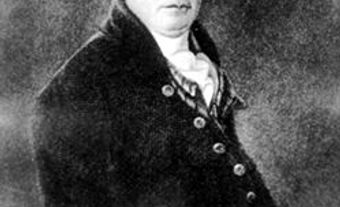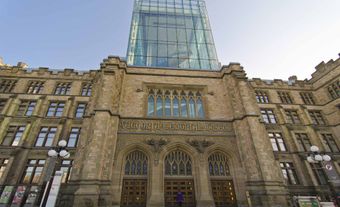Sault Ste Marie, Ontario, incorporated as a town in 1887 and as a city in 1912, population 72,051 (2021 census), 73,368 (2016 census). The city of Sault Ste Marie is located adjacent to the rapids of the St Marys River between lakes Superior and Huron. Across the river is the American city of the same name. Sault Ste Marie sits on the traditional territory of the Ojibwe, who called the site Bawating (“place of the rapids”) and valued it for its access to the upper Great Lakes and as a source of abundant whitefish and maple sugar. It is popularly called “the Sault,” or “Soo.”
Settlement and Development
In 1622, Étienne Brûlé was probably the first European to visit the area. The site is called Sault de Gaston on Samuel de Champlain’s map of 1632 (“sault” meaning “falls” in French). It became Ste-Marie du Sault when a Jesuit mission was established in 1668. The North West Company built a post here in 1783, developed the fishery as a major food source for the fur trade and dug the first canal past the rapids in 1798 to move boats and canoes. Fur trader Charles Ermatinger’s house, built in 1814-23, is the oldest stone house in Canada west of Toronto. It survives from that period and is now a national historic site (designated in 1957).
On 21 July 1814, when the Americans were trying to gain control of Lake Huron during the War of 1812, they burned much of Sault Ste Marie, including the trading post and wood lock of the North West Co. A second lock was opened in 1895 and at the time was the world's longest. Closed between 1987 and 1998 it is now only open for recreational traffic. It was designated a national historic site in 1987. Lake and ocean ships, with cargoes of grain and iron ore, bypass the rapids through four American locks (1855). Together the five locks regularly handle more traffic than any comparable system in the world.
Economy
Industrial development was initiated by American-born businessman Francis Clergue, who built an electric-power plant and pulp mill, the Algoma Steel Company (1900) and the Algoma Central Railway (1899-1914), which runs to iron ore reserves nearby. Clergue went into bankruptcy and the Ontario government was forced to step in and rescue some of the businesses.
Algoma Steel is still the major economic force in the area. At its peak, Algoma Steel employed some 9,000 workers, but with restructuring and changes in technology and economic patterns its payroll is now closer to 2,900. The forests of the Algoma region also support pulp and paper and wood-processing companies in the city. The Sault is the home of the Great Lakes Forestry Centre, one of five Canadian Forest Service centres across Canada. The centre is involved in research and development as well as policy making. Since 1924, the aviation and forest fire services of the Ontario Ministry of Natural Resources (first known as the Ontario Provincial Air Service) have been centred here. In 1957, the air service successfully developed aerial water bombing for fighting forest fires. Today the service maintains a large fleet of planes for fighting forest fires.
The Sault Ste Marie International Bridge was opened on 31 October 1962, furthering the city’s position as a focal point for east-west transportation. Sault Ste Marie supports numerous companies offering trucking services and has become an important regional centre for health, education and government services. The important role of transportation in the development of the city has been recognized in the establishment of a Marine Heritage Centre and the Canadian Bushplane Heritage Centre. Attempts are being made to diversify the city’s economy by introducing and encouraging development in such areas as information technology, renewable energy and tourism.
Cultural Life
The Sault Star has been the city's daily newspaper since 1912. Post-secondary education is provided by Sault College and Algoma University. The Art Gallery of Algoma is located in the city and the Sault Ste Marie Museum is located in the old post office (opened in 1906) with its impressive clock tower. Winter tourism and recreation activities include the Bon Soo Carnival, the junior hockey games of the Soo Greyhounds and downhill skiing at the Searchmont Ski Resort. Summer activities include boat tours of the locks and the Algoma Central Railway wilderness tours to Agawa Canyon. Parks and two full-service marinas, one named after Roberta Bondar, the first Canadian woman in space and a city native, have been developed to encourage boaters to visit the Sault.

 Share on Facebook
Share on Facebook Share on X
Share on X Share by Email
Share by Email Share on Google Classroom
Share on Google Classroom



